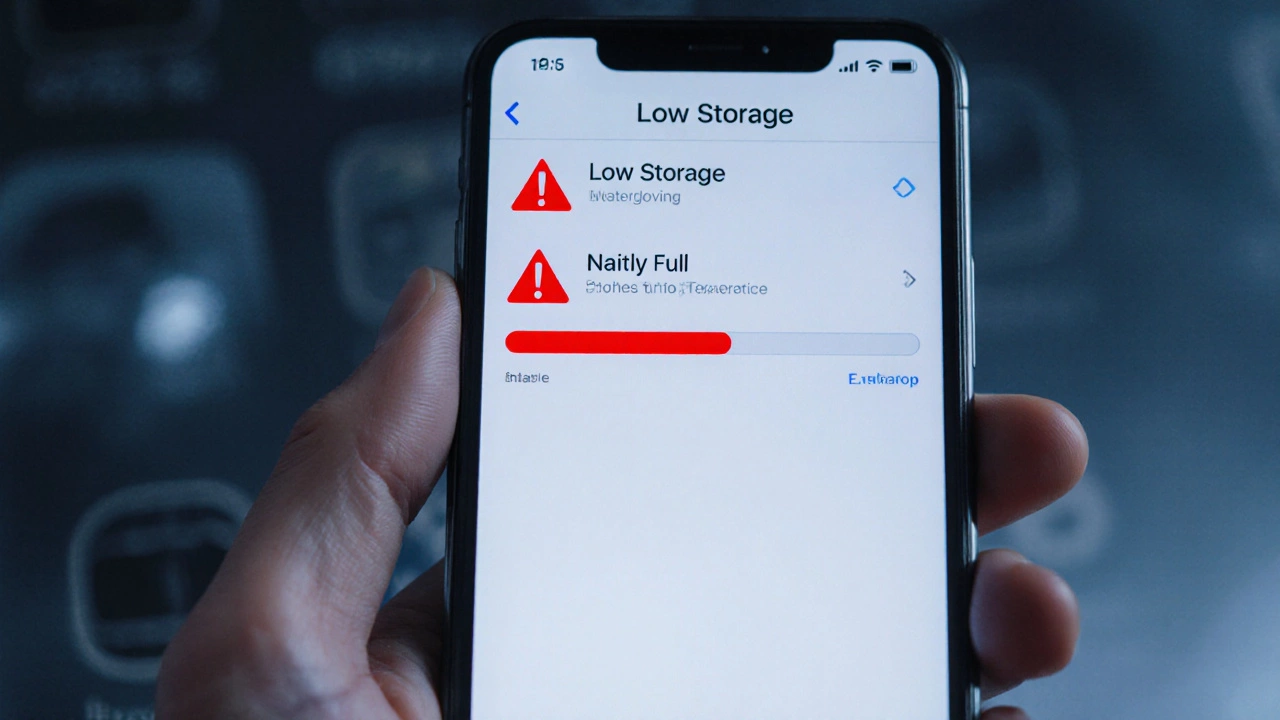
Storage Space Checker
Estimated Usage by Category
Cache Files
Temporary data stored by apps to improve load times. Usually safe to clear regularly.
Downloads Folder
Files downloaded from the internet. Often contains old or unnecessary files.
Photos & Videos
Media files often take up the most space. Use cloud backup to free local storage.
Apps & System
Operating system files, installed apps, and system logs.
Your Storage Analysis
Click "Analyze My Storage" to see how your space is being used.
When your phone, laptop, or PC starts warning you about low space, it feels like a roadblock to everything you want to do. Storage is a system component that holds files, apps, system data, and media so you can access them whenever you need. Keeping it free isn’t about a one‑time purge; it’s a habit, a set of tools, and a bit of planning. Below you’ll find a step‑by‑step playbook that helps you understand why space disappears, spot the biggest culprits, and set up defenses that work automatically.
Why Does Storage Fill Up So Quickly?
Before you can stop a problem, you need to know its cause. Most devices share three hidden habits that gobble space:
- Cache accumulation - apps store temporary data to speed up loading, but they rarely clean up on their own.
- Duplicate and forgotten files - the same photo, document, or video ends up in multiple folders.
- System logs and updates - operating‑system logs, old update packages, and crash reports linger for months.
Each of these categories can silently consume gigabytes, turning a device with ample capacity into a constantly “low storage” alert.
Spot the Biggest Space Hoggers
Identifying the offenders is easier than you think. Here are the five entities that usually top the list, plus how to spot them.
Cache - Most browsers, streaming apps, and social media platforms create cached files. On Android, Settings→Storage→Cache shows the total size. On Windows, use “Disk Cleanup” and tick “Temporary internet files”.
Temporary files - These are files created during installations, editing, or printing. They usually live in a system temp folder (e.g., C:\Windows\Temp on PC or /tmp on macOS).
Downloads folder - Anything you’ve ever downloaded ends up here, from PDFs to software installers. It’s a perfect graveyard for old files.
Duplicate files - Photos taken with multiple cameras or backups that were never merged create replicas.
System logs - Windows Event Viewer and macOS Console generate logs that rarely need to be kept after troubleshooting.
Daily Habits to Keep Storage Free
Good habits beat big clean‑ups every time. Try to incorporate these five tiny actions into your routine.
- Empty the recycle bin at the end of each day. Files sit there until you manually purge them.
- Delete old downloads before you close your laptop. A quick glance at the Downloads folder can save hundreds of megabytes.
- Clear app caches weekly. On Android, Settings→Storage→Cached data →Clear. On iOS, Settings→General→iPhone Storage and tap “Offload Unused Apps”.
- Organize photos into yearly albums and delete blurry shots. Use built‑in “Optimize Storage” features that keep low‑resolution previews on the device and full‑resolution files in the cloud.
- Run a quick duplicate scan once a month. Free tools like “Duplicate Cleaner” (Windows) or “Gemini 2” (macOS) spot copies in seconds.
Built‑In Tools That Do the Heavy Lifting
Modern OSes ship with utilities that automate many of the steps above.
Disk Cleanup (Windows) - Opens from Start→All Programs→Accessories→System Tools. Tick categories like “Temporary Internet Files”, “Recycle Bin”, and “Previous Windows installations”. Click “Clean up system files” for deeper access.
Storage Sense (Windows 10/11) - Turn it on in Settings→System→Storage. It automatically deletes temporary files and empties the recycle bin after a set number of days.
Optimized Storage (macOS) - In Apple menu→About This Mac→Storage→Manage, you’ll find recommendations like “Store in iCloud”, “Empty Trash Automatically”, and “Reduce Clutter”.
Files App (iOS) - The “Recommendations” tab shows large attachments, old videos, and unused apps you can offload.
Leverage Cloud and External Solutions
Even the best habits can’t stop an ever‑growing media library. Offloading is a smart long‑term strategy.
- Cloud photo backup - Services like Google Photos, iCloud, and OneDrive offer unlimited “high‑quality” storage for free. Keep originals in the cloud, then delete local copies. \n
- External hard drive - A 2TB portable SSD costs under $100. Use it for archives you rarely need, such as old project files or TV series.
- Network‑attached storage (NAS) - For households with multiple devices, a small NAS provides centralized backup and can serve media via Plex, keeping each device lean.
Automate Cleanup with Scripts and Apps
If you’re comfortable with a bit of scripting, automation removes the “remember to do it” step entirely.
On Windows, a simple PowerShell script can clear temp folders every night:
Get-ChildItem "$env:Temp" -Recurse | Remove-Item -Force -RecurseOn macOS, a cron job that runs a “rm -rf ~/Library/Caches/*” command does the same. For mobile devices, apps like “CCleaner” (Android) or “Smart Cleaner” (iOS) schedule cache clears.
Quick Comparison: Manual vs. Automated Cleanup
| Aspect | Manual Approach | Automated Approach |
|---|---|---|
| Time required | 10‑30minutes per session | Runs in background, 0minutes |
| Consistency | Varies with user discipline | Predictable, scheduled intervals |
| Risk of accidental deletion | Higher - user must double‑check each file | Lower - scripts target known temp locations |
| Customization | Limited to UI options | Highly customizable via scripts or third‑party apps |
| Long‑term effectiveness | Depends on habit maintenance | Steady, as long as schedule stays active |
Checklist: Keep Your Storage Free
- Enable Storage Sense or macOS “Optimized Storage”.
- Empty recycle bin daily.
- Clear app caches weekly.
- Review Downloads folder each week and delete unnecessary files.
- Run a duplicate‑file scan monthly.
- Back up photos and videos to cloud or external drive.
- Schedule a nightly script to purge temp folders.
Following this checklist lets you free up storage without feeling like you’re constantly fighting a losing battle.
Frequently Asked Questions
How often should I delete cache files?
Weekly is a sweet spot for most users. It clears out stale data without affecting app performance, which can rely on cache for speed.
Is it safe to delete system logs?
Yes, unless you’re troubleshooting a specific issue. Logs are only useful for diagnostics; most users can clear them safely.
What’s the best cloud service for photo backup?
Google Photos offers free “high‑quality” storage unlimited for most users, while iCloud integrates tightly with Apple devices. Choose the one that matches your ecosystem.
Can I automate duplicate file removal?
Yes. Tools like “dupeGuru” (cross‑platform) support command‑line arguments, allowing you to schedule scans with Task Scheduler (Windows) or launchd (macOS).
Will moving files to an external drive free up space instantly?
Absolutely. Once you transfer files and delete the local copies (remember to empty the recycle bin), the freed space appears immediately.




